#pruneface
Explore tagged Tumblr posts
Text
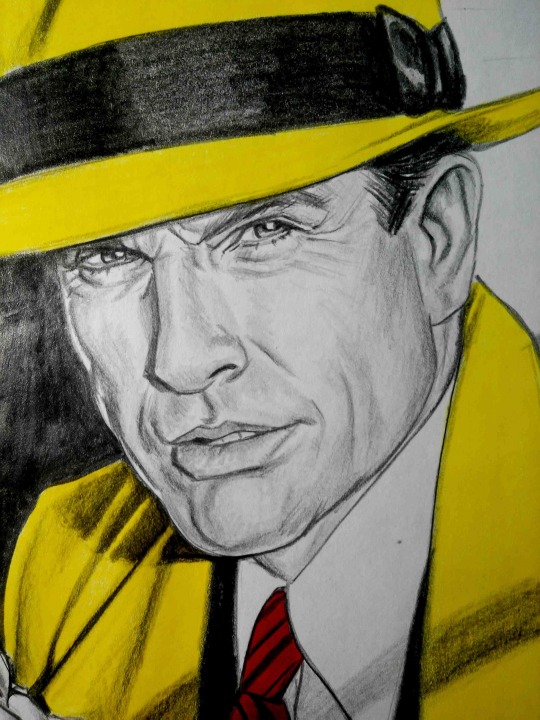
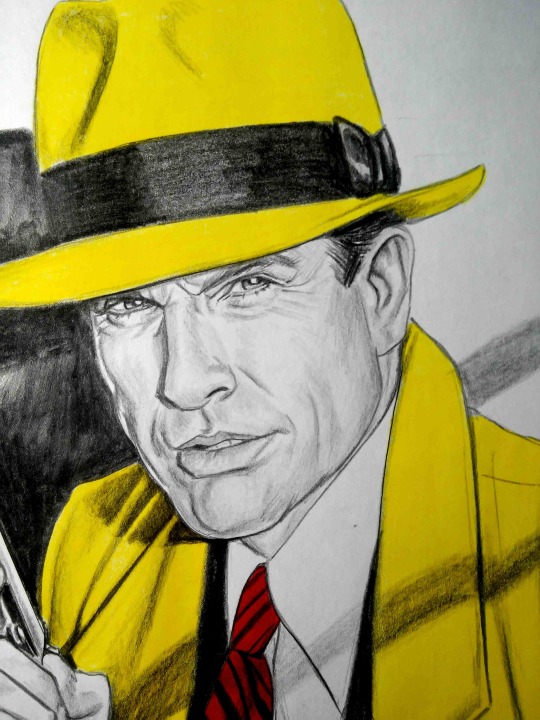
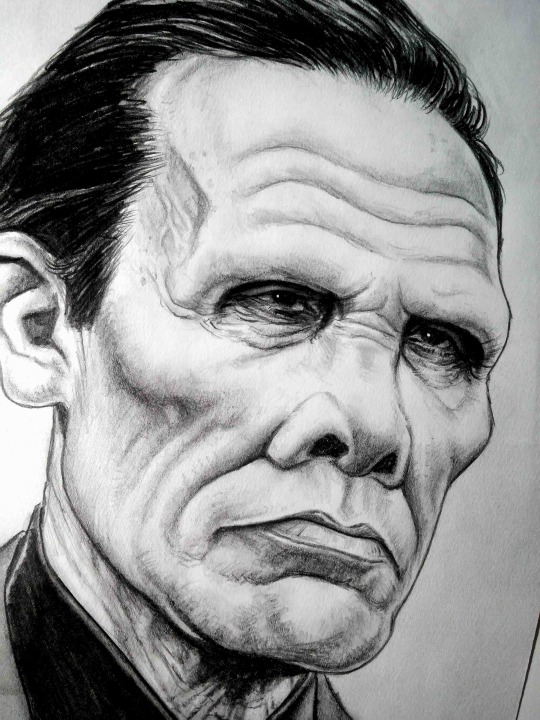




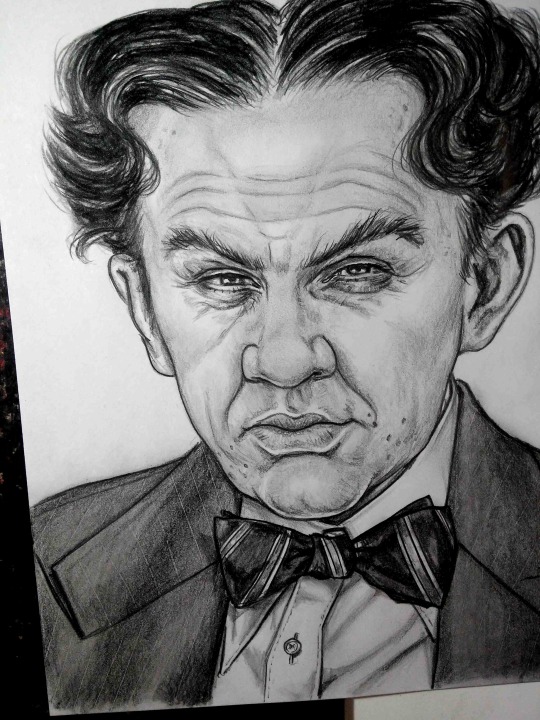

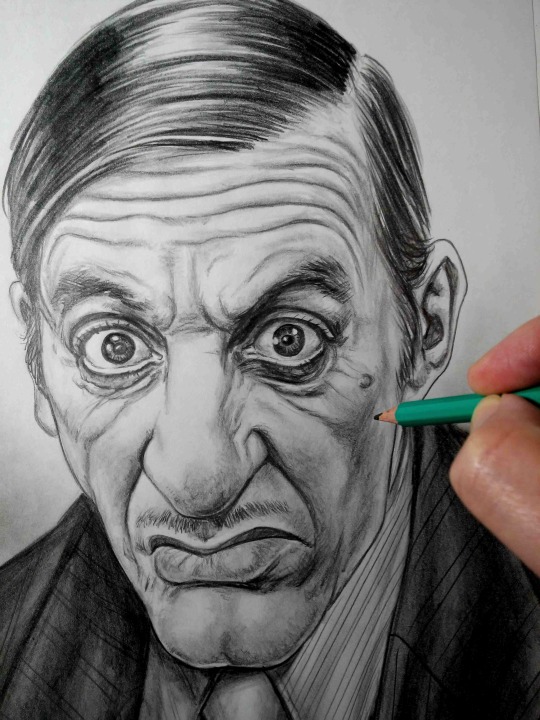
Big Boy Caprice: You get behind me, we all profit; you challenge me, we all go down! There was one Napoleon, one Washington, one me!
Dick Tracy Sketches
5 notes
·
View notes
Text

Late shift means late post means double post today!
I know very little about Dick Tracy apart from a singe Daffy Duck parody 'toon and a Simpsons reference featuring a young Ned Flanders mentioning him, Pruneface, Prune Tracy and someone else I can'tt remember.
I know there was a film starring and directed by Warren Beatty which I've not seen. I think he still wants to do a sequel?
0 notes
Text


Idk why but when watching the old UPA Dick Tracy cartoon I keep seeing the usual team-ups they have and thinking "oh they a couple" for some of them
#they all have unique pairing vibes too#q#stooge and mumbles are the sweet lovers who are wholly married life partners 5evr#pruneface and itchy are kinda toxic but like magneticly attracted to each other#flattop and bb eyes have the explosive chemistry and flattops a bad bitch#idk#dick tracy#upa cartoon#flattop jones#bb eyes#stooge villar#mumbles#mumbles amd stooge
5 notes
·
View notes
Text



Dick Tracy vs. Mrs. Pruneface
1 note
·
View note
Note
BEAST WARS LIVEBLOG. FOUR EPISODES.
sorry for all the back to back liveblogs i usually try space em out a bit but im very excited and ur very excited so im sending it in so i can watch the next eps sooner auufifigjdkjgkf tomorrow. maybe.
S3 EP7 (47)
go with the flow...
more spideybots!
omg its the kids again 🥺 awwwwww... cute...
POP OP... LKJHSKJDHF PRUNEFACE,, rattrap i cant take all these back to back
Cheetor is teaching the kids!!
lever......................... PULLEY...LADHAKJ
ouhhhh what are the predacons building...
the fucking camera just dropping closer to the protohumans... AHDJFHEK OH IT WAS REALLY DOING THAT
"this bot tries for positive programming" GDJFOFDJEFBFKFHEL
UNA NO!!!!!!!!! D:
depth charge is here!
aww una and chak... :((
DEPTH CHARGE... he wanted to go off alone again
omg shes learnt so much <3 go for the hinges!!
waspinator: "she injuring waspinator!"
Megatron: "ohhh! situation normal then!" LMAO
wwwuh oh theyr shootin the Beam.
WUH OH DC IS OUTTA POWER
"i aint dead!" "this day is just FULL of disappointments." GrjfkfhdHFKFBD
RATTRAPS JUST LEAVING HIM THERE... AHAHAHFVDJDBFJRMWLJGRLFBRMGNEK
butterfly stops on Depth Charges chest... "what're YOU lookin at?"
...
...
...
i wanna be that butterfly. i mEAN WHAT WHO SAID THAT.
megatron trying to get una to do things... GRJFIFBEK very cute
oh no... dinobot :(
TARANTULAS WHAT ARE YOU PLANNING TO DO WITH HERRR D: hes so creepy.
AHSJFKFJEKDHFKDJFDK
LEVER !!!!! SHE LEARNT!!
awhwjdfjdkf,, make like a boat and FLOAT
shdjfkfjedjdk all 3 predacons smackin into each other
oh NO........
EHRJFHEJ? RGSKFHDKFNDKDNF
UNA KEPT THE SHINY THING una ily
oop the explosion still had a big shockwave
i love. rattrap and depth charges dynamic. rattrap just gets along really well with ornery guys.
S3 EP8 (48)
Crossing the Rubicon
............. HEY. IVE SEARCHED UP RUBICON BEFORE. ISNT THAT... DOESNT THAT MEAN POINT OF NO RETURN.
gasp!!! BLACKARACHNIA ... tm2 BA real?
why did she give the pod spider legs as well.
oh shit silverbolt
👀
OHH................. :(
DUN DUN... never before done operation...
:00... the tension...
awwh,, AWWWWWWWWWWW sappy as always <3
WAHHH,,,,,,,,,, OH SHIT IS SHE GIVING THEM THE ACCESS CODES...
this is so stressful,,,,,,,,,,
i LOVE these visuals
OH HSKSRLFMRLWNEMNF
TARANTULAS! he was snoring LMAO,, hes so nasty 99.99% of the time but. i think that was. kinda cute u_____u
hes like. my unreasonable weirdo fav. like even i dont get it but i like him anyway.
AUAUGHGH...
"this fits with our plans for [Optimus]" what NOW
SHRJFKFKDJEKFB MEGATRON SQUISHED A RUBBER DUCKY!
IM EVEN MORE STRESSED OUTBTHAN BEFORE
OH GOD
aHHh,, maximum stress!!!
RAMPAGE !! havent seen him in a while <3333
auauuususuhhfhdhhhh,,
OH GOD. TARANTULAS. NOO
AHHHHHHHHHHHHHHHHHHHH
🥺🥺😭😭😭😭😭😭 NOoooooOoOOOO BLACKARACHNIA ?!?!
"TARANTULAS.............." Oh hes IN for it now.
hhhhghgh :(
the silences are so :((
"OH NO" OH NO!!!!!!!!! (<- editinit: I DO NOT REMEMBER WHAT PART THIS WAS ABOUT. OH NO, I GUESS.)
OH. OH!! THE ALIEN THING. OH FUCK
Oh FUCK
Ahahshfjkfkelsflgnfmmrlrkwntngntkwjrjgle
AHHHH !!! blackarachnia...
RAMPAGE!! "ah such pain... i must help... deepen it"
PLEASE PELASE PLEASE DONT BE ANOTHER SHAKESPEARE REFERENCE. IVE SEEN THIS PLOT BEFORE DONT ROMEO AND JULIET THEMMMMMMM PLEASE,,,
IHHAHAHJJFKGKGHDJK Oh fuck!! LETS GOOOOOOOOOO
Oh she looks SO COOL
WAAAHAHJJKRJTHFKDHFKEHFKFJFKDJFKDLGNRK LETS GO!!!!!!!!!!!
SB's lil gulp. LMAO me too buddy
Rampage: "LOVE the new look. GOODBYE!" at least he acknowledges that she SLAYS
i am a big fan of rampage gettin whirled around again. this is great
AWUAUAUAGHV SB and BA are so CUUUUUUUUUTE <3333
im so glad they didnt romeo and juliet them. id have been so so upset if they did 😭😭
and now we've got transmetal2 blackarachnia!!!!!!
S3 EP9 (49)
master blaster... smth smth insert master baiter joke here.
waspinator :(
HE GOT FLATTENED. SWUARSHED. PAPERIZED.
tarantulas... at least its not OPs ass again.
oh i am so very normal abt these internal shots.
OUGH...
"sure thang!" HRKFHDK? QUICKSTRIKE...?
Take A Rest!
OH.
poor cheetor gettin punched Again.
oh so spooky...
i really like that the deco on BA's head moves, it looks really neat
"power outage" UH HUH...
BIG HANDS...
oh it IS QS. deeply unsettling hearing his voice from OP
OhHHHHHHHHHHH,,, everyones trapped
but depth charge is still somewhere out there................. somehow i dont feel like hes gonna be any help
hhrhhgh. rampage holdin BA. his scary lil laugh. <3333
theyr making their way onto the ark again !!!! aHH
i am unwell. rampage taunting blackarachnia. ohuuhhghbntbngnnb <3
SHES GOT TELEKINESIS??
Megatron: "ahHhh...~" dont tell me hes gonna monologue AGAIN
oh! Megatron ... OG Megatron!
oHHHHHHHHHHHHH
hrhhrhhhhehdhhhf okay. 1. really interesting to see how many layers Megatron (BW) has around his spark esp. compared to OP last time and also 2. HEY WHATS UP WITH THR WEIRD SPIKED TENTACLE? why. why.
hejedkhfkd HE JUST PRESSES A BUTTON AND BAM. MEGATRONS CHEST IS UNFOLDING like I feel this is a tactical oversight.
FLAILING ...
GASP.
its been SO long since we've had some good ol TREACHERY.
TIME FOR ANOTHER ATTEMPTED TAKEOVER <3333
OHUGUFJHDJDHDH??!?!?
Hes Floating... WHY CAN HE SURVIVE THE LAVA BUT NOT TERRORSAURRRRRRR
Oh god. Tarantulas... oh hes so narsty
OH FUCK MAYBE MEGATRON DIDNT SURVIVE
unless. OG!Megatrons spark. yknow.
i kinda assume this is what happened because time isnt unravelling
TARANTULAS WHAT IS YOUR PLAAAAN...
QS is such a Freak (/neg)
IS TARANTULAS' PLAN JUST TO KILL EVERYONE? LIKE EVERYONE EVERYONE?????
Wgrjfifhdkfbkd BA LOCKED INFERNO OUT ahahshshhfjdjdjfs
WOAHAHDJFJFHSJAHHAHAHAHA YESSSSSSS HES BACK...
...... dragon megatron 👀?? <- (has watched like. 5 episodes of TF RID 2001)
OKAY THAT FUCKS.
YESSSSSSSSS DRAGON!! MEGATRON!!!!!
LMAO. is he a one or 2 headed dragon though....
one head! Still FUCKING AWESOME
Quickstrike. is so creepy but in a bad way that i do not Like.
"i can suffer your treachery lieutenant, not YOUR INCOMPETENCE." Yeets Tarantulas. "Treachery requires no mistakes."
these are such banger lines. the line delivery is just mwah mwah top notch
he survives his dip in the lava TOO.
"core implosion aborted. all systems normal. have a nice day" WHDKFKFJEKFNKENFKE
Megatron has got ICE powers as well?!?!?
yaaaay everyones back online <3
wait wheres my boy depth charge :(
man. man. dragon Megatron FUCKS <33
i try to mostly ignore the thumbnail for the next episodes but the next one has what looks like Megatron in a judge wig?? which is. an image for sure. i cant wait to find out what the fuck thats about LMAO
S3 EP10 (50)
Other Victories...
WHERE IS THIS. WHOS THIS??????
WHO ARE THESE.
OH!!!!!!!!! THE ALIENS!!!!!!!!!!!!!!!!!!!!!!!!! THE VOK
OuHRHRHHEJSJDHJDHFJDHDJDJFHDJ AIRAZOR AND TIGATRON?!?!?!?!?!?!?!?!?!?!?!!/?
?!?!?!?!?!?!
only one body though...
Ahrjfkfjd OH SO IT JUST STARTS OFF WITH MEGATRON IN THE JUDGE WIG. OKAY.
i love a good courtroom scene. this is gonna be great.
waspinator is the lawyer?!?!?!?!?!?
"waspinator LIKE defense! maybe a little MORE defense and maybe waspinator not get blown up all the time" aww...
AHRHRHGHFJSJJGJRJGJKEHTJFJFN inferno is taking minutes. hes got a type writer im gonna fucking cryyy RBFJFKDJ
LMAO WHAT A HORRIBLE DEFENSE
OH FUCK QS...
HSJDKFNFKSNFMFBFKS saved by the alarm
what the FUCK is Tarantulas doing. hes making horrible noises again. oh hes Steaming. hes being a little hater.
THEYR GONNA HIT THE PREDACON BASE?!
ZYEUUUUM
!!!!!!! OHHHH FUCK. abandon base..............
oh it was OBLITERATED
Rattrap.
AHHHHHHHHH WAHHRJRJFHDJHDJW WAIT WHAT.
TIGERHAWK ??????? TWO SPARKS ONE BODY?
WOAH
"at least this time waspinator was companyyyyyyyy!" AWHDJFHD
we're all gonna die...
OOP tarantulas!
👀 Tarantulas isnt even upset that OP arrived. WHAT IS HE PLANNING...
...... TIGERHAWK JUST. HUUUHHGDHJF? the earth swallowed up OP...
OH! spiderdroids...
AUFIGHRJEKBFJD DID ONE GO FOR HIS CROTCH????
AND HIS ASS!!!!!!!!!!!!!!! AGAIN
👀👀👀👀👀👀
wait WHAT. THOSE are Airazor and Tigatrons sparks.
their sparks fused(?!?!?)
ALSO WHY DOES CHEETOR KEEP HAVING ALL THESE WEIRD DREAMS. why doesn't anyone else VEJFFB
PHEW op is okay
:]
HUHHHHH... oh my god Tarantulas loredrop?!?!
i and the tripedacus council have DIFFERENT origins... HELLO?
>:00000000
AHJDHFJDBDJDBFJDJ he tried to do the fucking. cross at the ghosty aliens LMAO
OH FUCK???????????????
My BOY
OHUUHHHGHHD THAT WAS COOL. BUT ALSO D:
IS HE GONE?? IS THAT IT FOR MY BOY???? is tarantulas dead 😭😭😭 ayuuuygdfhljhckhkc
... okay. at least. Tigatron/Airazor are KINDA back. but as a new character (?!)
tigerhawk is cute,,,,,,,,
BUT LIKE SERIOUSLY IS TARANTULAS DEAD?? oh my god there are only 2 episodes left in the playlist thIS SEASON BETTER NOT LEAVE OFF ON ANOTHER CLIFFHANGER I CANT.
also the LORE before IMMEDIATELY KILLING(?) TARANTULAS. AUGH.
yelling. just in general. id have split this up but it's nearly the end of the season and AHhhhHhhHhhHhhhHhh,,,,,,,,,,,,, HHHHH feral scream felt like 20x longer than it actually was and these all felt 20x shorter than they actually were but in a good way. so much. happens.
- initiate
5 notes
·
View notes
Text
Q: what are some good ghost names?

I wanted to work Anne Boleyn in somehow, but I ran out of room.
My suggestion is that you can either simply use the name of actual historical figures (Adolf, Pruneface, Caspar Weinberger), since they’re safely dead, or you can go Treehouse of Horror and turn everything into a bad pun: Bat Groening, Ghoulie Keven, Hallowian Maxtone-graham … the choice, as they say, is yours.
13 notes
·
View notes
Text
"A man, a woman, another woman, and then the child who belongs to all three of them, come screaming and beautiful into a some cool dawn several thousand years ago. When I was a kid I remember noticing that the colors on the Sunday comics pager were actually made up of thousands of individual color-dots: I would hold the paper up close to my eyes to make sure I wasn't seeing things. I wasn't. The last frame I ever saw whole before learning the truth was a picture of Pruneface, one of Chester Gould's finest. It seared itself into my memory, and then all total pictures were gone, collapsed into limitless oceans of infinite constituent parts. Still, one tries to hold onto the picture before it breaks apart. You only get to see it once." - The Life of the World to Come: a film by Rian Johnson, liner notes by John Darnielle on "Genesis 30:3"
#the mountain goats#tmg#the life of the world to come#genesis 30:3#liner notes#quotes#saw this on the wiki and holy moly
6 notes
·
View notes
Note
Is it too late for a Dick Tracy question:
Do you think it had franchise potential?
Not too late.Im not doing the review ,cause Im gonna rank the movies but I will answer any movie questions
I think it did.....But the movie kind of throws away that potential..cause....OK WArren Beatty decided to have not one ,not two ,but ALL Of Dick Tracys villains in the movie .....AND ALL OF THEM ARE DEAD .The only villains who make it out alive are 88 Keys and Mumbles .I am particularly baffled that Flattop,Dick Tracys probabbly most recognizable villain is just a henchman here
I think if he wanted a sequel,just have Big Boy,Breathless,Mumbles and Itchy as the villains ,save Flattop or Pruneface as villains for the sequel
@ariel-seagull-wings @theancientvaleofsoulmaking @themousefromfantasyland
6 notes
·
View notes
Text
LUCY & THE SUNDAY FUNNIES
A Look at the Comic Strips of the Lucyverse

Comic strips and comic books are part of pop culture history - just like Lucy - so it is natural that the two sometimes collided. Here are some examples of popular comics that went from the Sunday funny gage, to the Monday night tv fun!
DICK TRACY
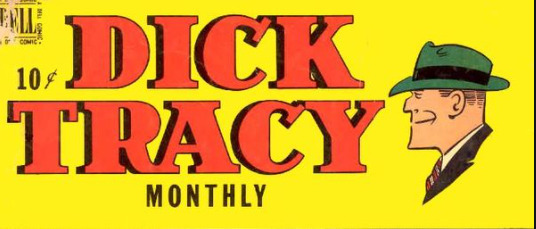
Dick Tracy is an American comic strip featuring a tough and intelligent police detective created by Chester Gould. It made its debut on October 4, 1931 in the Detroit Mirror, and it was distributed by the Chicago Tribune New York News Syndicate. Dick Tracy has also been the hero in a number of films, two of which were released in 1947. From 1934 to 1948 "Dick Tracy" was also radio serial. Tracy was mainly heard about on Lucille Ball's radio show, "My Favorite Husband" (1948-1951).
"SECRETARIAL SCHOOL" (February 18, 1949) Liz begs the Blabbermouth on the party line to allow her to make a quick call.
LIZ: “Do you have to use the telephone?”
BLABBERMOUTH: “Whaddya expect me to use? A two-way wrist radio?”
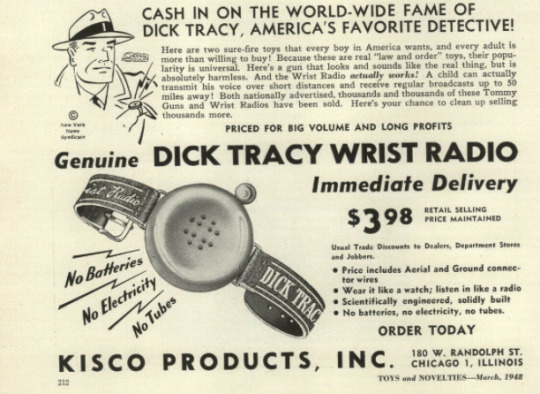
In 1946, Dick Tracy introduced a two-way wrist radio. In 1948, that cartoon item was brought to reality, along with a myriad of other Dick Tracy-themed toys.
"THE ANNIVERSARY PRESENTS" (May 13, 1949) Liz is positive that George will remember their anniversary. After dropping several hints, George still hasn’t said anything. Finally, he looks up from his newspaper with something to tell her.
GEORGE: “Dick Tracy found the jewels!”
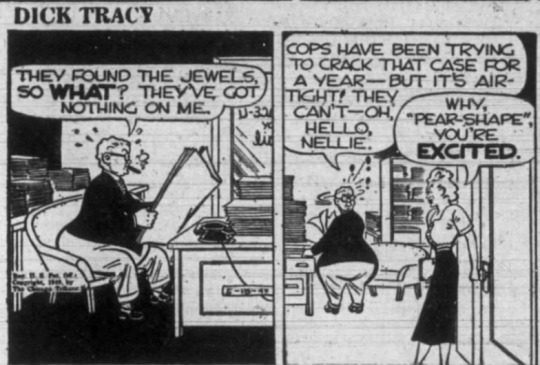
On May 13, 1949, the daily Dick Tracy comic strip revealed that the missing jewels has been found. The case involved a character named Pear-Shape, who owned a weight loss business but was overweight himself. He conned an elderly widow out of the jewels and sold them to a fence.
"GETTING OLD" (May 20, 1949) Liz find a book she forgot to return to the library, long overdue. George wants to donate it to their tag sale, but Liz refuses to handle ‘hot’ merchandise. George sarcastically calls her Pear-Shape.
George is not referring to Liz's waistline, but to the character in the Dick Tracy comic strip named Pear-Shape Tone, who was part of the storyline from April to July 1949. He was a racketeer who would steal jewelry from his wealthier clients, then fence it to make a profit.
"LIZ IN THE HOSPITAL" (May 27, 1949) As George speeds toward the hospital a cop pulls them over. Liz thinks that if she gets arrested she can’t go to the hospital so she tells the officer that they are driving a stolen car. When George tries to interrupt, she calls him Pear-Shape to further reinforce her fake story of thievery.
Pear-Shape must have been quite popular in May 1949, because this is the third consecutive episode of “My Favorite Husband” where he is mentioned!
"LIZ AND GEORGE ARE HANDCUFFED" (December 30, 1949) George overhears Liz playing out a scene from Dick Tracy with little Tommy Wood from next door, who got a Dick Tracy outfit for Christmas and has been playing cops and robbers ever since. Liz says his sisters won’t play Tess Truehart to his Dick Tracy. George corrects her that she is now known as Tess Tracy, since Dick and Tess recently got married.
LIZ: “You mean I’ve been playing around with a married man?”
On December 25, 1949, just five days before this broadcast, Dick finally married his girlfriend, Tess Truehart.
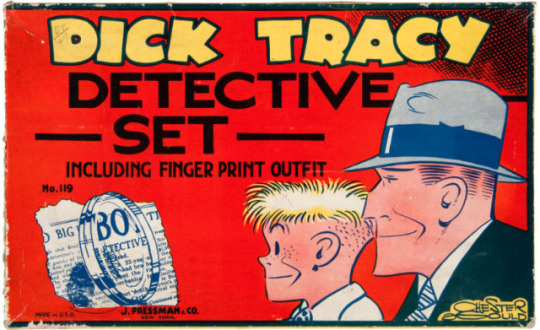
Little Tommy ‘Tracy’ comes over to show ‘Pruneface’ Cooper (Liz) his badge, handcuffs, and finger print outfit.
LIZ: “Tommy, is it true that no two people in the whole world have the same fingerprints?”
TOMMY: “Nah, that’s a lot of bunk. I’ve already found three people who have exactly the same fingerprints; my daddy, Santa Claus, and the crook who broke into my piggy bank.”
"THE JIMMY DURANTE SHOW" (April 29, 1948) Lucille Ball guest stars in an episode where they take a magic carpet around the country to see how things might be different if women were captains of industry. In Paris, Illinois, they visit the second largest perfume factory in the country, owned by Hot Breath Houlihan.
DURANTE: “Now I know who set B.O. Plenty’s house on fire!”

B.O. Plenty was a character from Dick Tracy comic strip. In March 1948, his house mysteriously burned down and everyone feared the character was dead. Readers actually wrote to the newspaper begging Chester Gould not to kill off B.O. Plenty and Gravel Gertie!
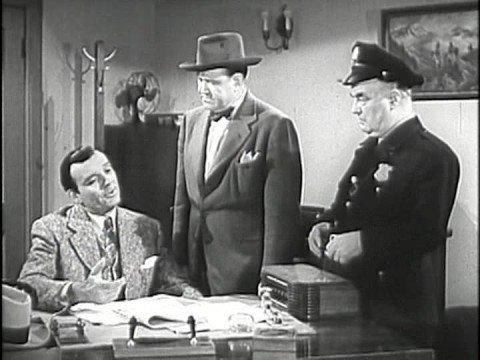
From 1950 to 1951, "Dick Tracy" was a television series, ending just a few months before "I Love Lucy" went on the air. Dick Elliott (right) made his television debut as Officer Murphy. He had done several films with Lucille Ball and appeared on "I Love Lucy" in two episodes. Likewise, Pierre Watkin played Police Chief Pat Patton. He had also done several films with Lucy and two episodes of "I Love Lucy."

Ten years later there was an animated series titled "Dick Tracy" featuring Lucille Ball alumni Jerry Hausner, Benny Rubin, and Mel Blanc.
In 1967 there was a pilot for a new live-action "Dick Tracy" series that went unsold. It featured Eve Plumb and Victor Buono, who later did episodes of "Here's Lucy," but were far more famous for other shows.
LI'L ABNER
Li'l Abner was a satirical comic strip that featured a fictional clan of hillbillies living in the mountain village of Dogpatch USA. Written and illustrated by Al Capp (1909–1979), the strip ran for 43 years, from August 13, 1934, through November 13, 1977. The strip inspired a 1956 Broadway musical that was filmed in 1959. Prior to that there was a non-musical film in 1940. A radio series was heard from 1939 to 1940.
"GEORGE ATTENDS A TEENAGE DANCE" (November 20, 1948) This episode of "My Favorite Husband" opens with Liz reading the morning papers over breakfast.
LIZ: “Who do you suppose got married?”
KATIE THE MAID: “Li’l Abner and Daisy Mae?”
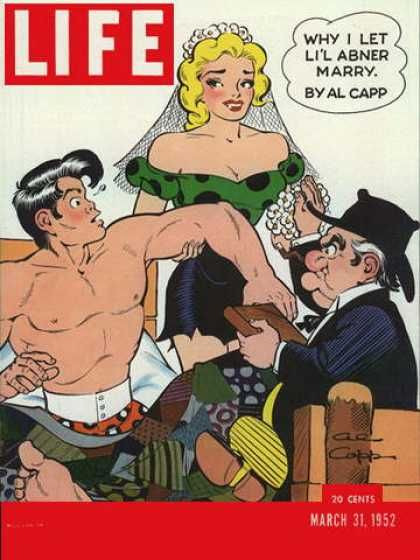
Almost from the start, Abner Yokum was being pursued for matrimony by Daisy Mae Scragg. The reading public found it quite a tease that the two were clearly destined to get together. They finally married in 1952, nearly four years after this broadcast. The event made the cover of LIFE Magazine.
"LIZ LEARNS TO DRIVE" (November 13, 1948) George reads about his old college girlfriend, Myra Ponsenby, in the morning paper. Liz is unenthusiastic.
LIZ: “What’s new in Lower Slobbovia?”
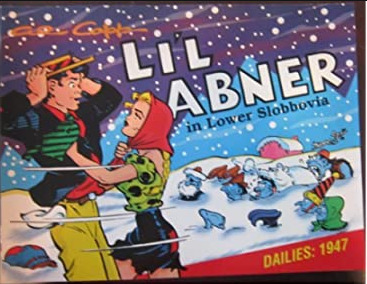
“Lower Slobbovia” was a term first used in 1946 by Capp to describe a place that was unenlightened and socially backward. The term entered popular culture when referring to any place hopelessly stuck in the past.
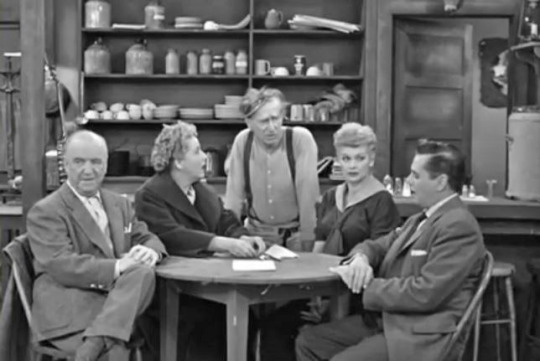
"FIRST STOP" (January 17, 1955) Fred Mertz calls the rundown Ohio roadside diner "Lower Slobbovia.”
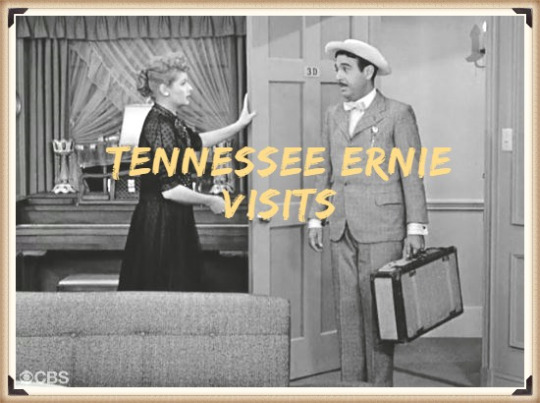
In "Tennessee Ernie Visits" (May 3, 1954) Fred calls Cousin Ernie "Little Abner".
The Broadway musical and film adaptation starred Peter Palmer as the title character. Palmer played Brother Peter in Lucille Ball's failed NBC sitcom "Bungle Abbey" (1980). On Broadway, Daisy Mae was played by Edie Adams (aka Mrs. Ernie Kovacs), who played herself in the very last episode of "The Lucy-Desi Comedy Hour" (1960). The film also featured Lucy players William Lanteau, Alan Carney, Bern Hoffman, Bobby Jellison, and Torben Mayer.
The 1940 film featured Lucy's mentor Buster Keaton as Lonesome Polecat and Dick Elliott as Marryin' Sam. A new 1971 musical special featured Lucy alumni Carol Burnett, Ken Berry, Eddie Albert, and Donald O'Connor. In 1967, "Here's Lucy" director Coby Ruskin created a pilot for a "Li'l Abner" series that failed to sell.
LITTLE ORPHAN ANNIE
Little Orphan Annie was a daily comic strip created by Harold Gray and syndicated by the Tribune Media Services. It made its debut on August 5, 1924, in the New York Daily News. In 1930 it became one of the first comic strips adapted to radio, and attracted about 6 million fans before leaving the air in 1942. It was adapted to film in 1932 and 1938, and (like Li'l Abner) even became a Broadway musical. The success of the 1977 musical is credited with revitalizing the popularity of the franchise. The musical was filmed in 1982, 2014, and for television in 1999.
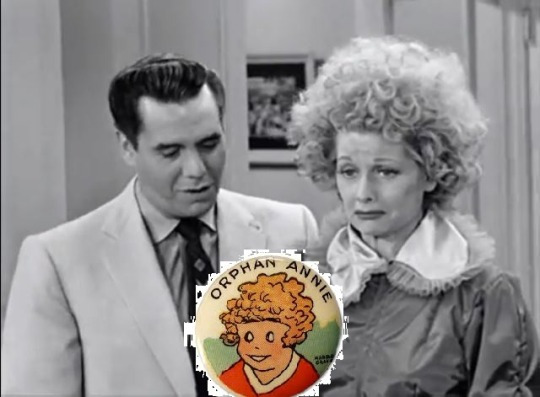
"LUCY WANTS NEW FURNITURE" (June 1, 1953) Lucy likens her over-permed hair to a chrysanthemum, while Fred calls her Little Orphan Annie.
Annie is generally depicted with a mass of red hair and a red dress with a white collar.
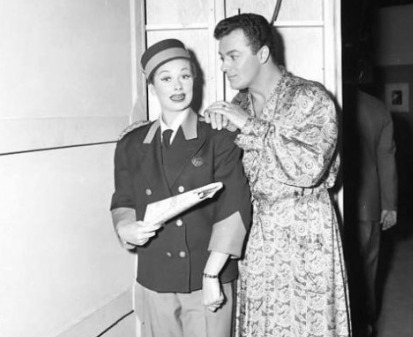
"THE STAR UPSTAIRS" (1955) Cornel Wilde is trying in vain to read a soaking wet newspaper thrown to him in the bathtub by Lucy disguised as a bellboy.
WILDE: “I thought President Eisenhower was playing golf with Little Orphan Annie.”
Eisenhower was famous for playing golf and Annie was famous on the comic pages, so it easy to see a mash-up of the two from a soggy paper.
"LUCY AND ART LINKLETTER" (January 10, 1966) Seeing Lucy’s wide-eyed look, Mr. Mooney tells her to "stop looking like an over-aged Orphan Annie.”
In the comic strip, Annie's eyes have no pupils!
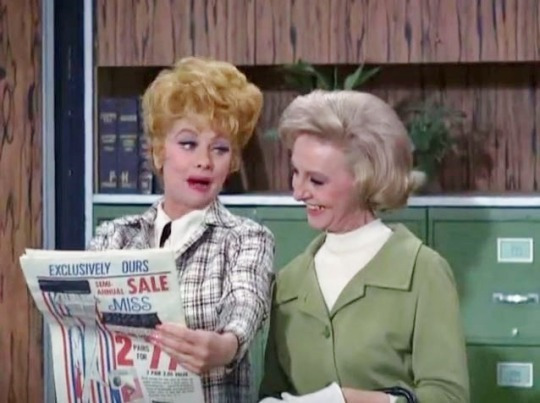
"LUCY GETS TRAPPED" (September 18, 1967) Lucy calls in sick, but goes shopping instead. When she's named Customer of the Year in a big celebration, she tries to hide the newspaper with her picture in it from Mr. Mooney. She tells him there's nothing new in the newspaper.
LUCY (about the news): "Oh, the temperature’s up, the stock market’s down, and Little Orphan Annie is lost again!”
During its 86 years of publication, Annie being lost or having disappeared was a frequent storyline. In fact, when the strip finally ceased publication in 2010, it ended with Daddy Warbucks "resigning himself to Miss Annie's being lost forever."
SUPERMAN

The Man of Steel was introduced to the world in comic book form in June 1938, created by Jerry Siegel and Joel Shuster. Beginning in January 1939, a daily comic strip appeared and a color Sunday version was added that November. Since then, the character, and characters from his world, has been seen in virtually every form of media, including, of course, television.
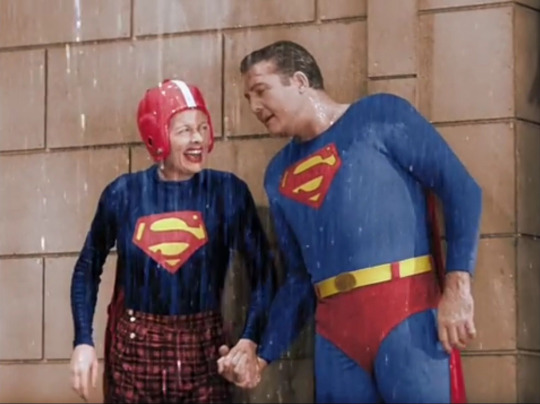
"LUCY AND SUPERMAN" (January 14, 1957) is considered one of television's first 'cross-over' shows. "The Adventures of Superman" aired from 1951 to 1958 in syndication, concurrent with "I Love Lucy". It starred George Reeves as Superman, a role he also plays on this episode of "I Love Lucy." While "Superman" made the transition to color in 1954, CBS kept "Lucy" in black and white for its entire run. Reeves is never mentioned by name in the dialogue or in the original credits, although it is pretty clear that Lucy and Ricky are recruiting "the actor who plays Superman" to entertain at Little Ricky's birthday party, not the superhero himself. Keith Thibodeaux (Little Ricky) later said that this was his very favorite episode. Because Desilu had obtained the license to use the actual Superman logo, they weren’t shy about using it! They even got permission to use the show’s theme music, composed by Leo Klatzkin.
Actors who were also seen on “Adventures of Superman” and their (characters) on “I Love Lucy”: Doris Singleton (Caroline Appleby), Elizabeth Patterson (Mrs. Trumbull), Tristram Coffin (Harry Munson), Herb Vigran (Jule / Al Sparks / Joe), Claude Akins (Himself aka ‘Giant Native’), Hayden Rorke (Mr. O’Brien), Phil Arnold (Harry Henderson / Man in Hotel Hallway), Milton Frome (Bill Henderson), Pierre Watkin (Mr. Dorrance), Dick Elliott (Tourist at Empire State Building / Yankee Stadium Spectator), Maurice Marsac (Maurice / Waiter), Frank J. Scannell (Buffo the Clown), Lou Krugman (Hollywood Director / Jewelry Salesman / Club Manager), Joi Lansing (Herself / Miss Low Neck), Larry Dobkin (Counterman / Waiter / Counterfeiter), Rolfe Sedan (Paris Chef), Eve McVeagh (Roberta the Hairdresser), Norman Varden (Mrs. Benson), Danni Sue Nolan (Mr. Reilly’s Secretary), Harry Cheshire (Sam Johnson), Ken Christy (Ken the Detective / Dock Agent), Robert Foulk (Brooklyn Policeman), Sid Melton (Jockey / Bellboy / Shorty), Bert Stevens (Tropicana Patron), Harold Miller (Theatre Patron / Ship Passenger), Hans Moebus (Man on Dock), Ernesto Molinari (Vineyard Boss), Jack Chefe (Bellhop / French Waiter), Bess Flowers (Tropicana Patron / Theatre Patron), and Monty O’Grady (Ship’s Passenger / Man at Airport).

Picking up Little Ricky’s toys, Lucy holds one of his “Superboy” comic books. It is the December 1956 issue (#53), hot off the presses during filming. Ironically, on the cover, Superman is looking at television! Even more ironically, inside the comic book was an ad titled “Draw Bob Hope”. Hope had just appeared on the season opener of “I Love Lucy.”
BATMAN

Batman was created by Bill Kane and Bill Finger in May 1939, just a year after Superman. As with Superman, there were numerous radio, film, and television adaptations of the characters, most notably a series starring Adam West that aired from 1966 to 1968.
Alas, there is no direct reference to the Caped Crusader in the Lucyverse. There are, however, plenty of indirect references due to the large number of actors who appeared on the television series who had also appeared with Lucy: Madge Blake, Cesar Romero, Van Johnson, Shelley Winters, Liberace, Tallulah Bankhead, Ethel Merman, Milton Berle, Rudy Vallee, Ida Lupino, Howard Duff, Stafford Repp, Victor Buono, Vincent Price, Edward Everett Horton, Vito Scotti, Norma Varden, Tristram Coffin, Ellen Corby, Sammy Davis Jr., Allen Jenkins, Art Linkletter, Alan Hale Jr., Jessyln Fax, Ben Welden, Dick Kallman, Alberto Morin, Bryan O'Byrne, and Larry Anthony.

Most notable among these is Madge Blake, who played Aunt Harriet on "Batman" as well as two characters on "I Love Lucy" and one on "The Lucy Show." She was also seen with Lucy and Desi in The Long, Long Trailer (1954). Coincidentally, she played Martha, a prospective new tenant in "Lucy and Superman" (see above). When she sees something outside the apartment window, her husband Herbert is concerned.
HERBERT: “Was it a bird?”
MARTHA: “No.”
HERBERT: “Was it a plane?”
MARTHA: “No.”
HERBERT: “Well, what was it, dear?”
MARTHA: “It was Superman!”
A 1949 film titled Batman and Robin featured Lucy performers Jack Chefe, Lyle Talbot, William Fawcett, and Phil Arnold.
DENNIS THE MENACE

Dennis the Menace, a comic strip centered around a mischievous but good natured young suburban boy, made its debut on March 12, 1951 syndicated in newspapers. Its success inspired comic books and (most famously) a television series that aired from 1959 to 1963.

"LUCY THE ROBOT" (February 28, 1966) Jay North, who played Dennis, guest-starred on a 1966 episode of "The Lucy Show" playing the 13 year-old nephew of Mr. Mooney (Gale Gordon). Lucy dresses as a toy soldier robot to divert him.
“You will keep that MENACE subdued for the next eight days!” ~ Mr. Mooney to Lucy about Wendell
During the final season of "Dennis", the long-suffering character of neighbor George Wilson was written out due to the death of actor Joseph Kearns. Kearns had played two characters on “I Love Lucy” - a psychiatrist in season one, and a theatre manager in season six. Gale Gordon was added to the cast as George’s brother, Henry.

When Lucille Ball was finally convinced to return to network television in 1962, she naturally wanted Gordon to join her, but he was unavailable due to his prior commitment to “Dennis the Menace” so Mrs. Carmichael’s put-upon banker was played by Charles Lane. Lane was also on “Dennis” as the recurring character of druggist Mr. Finch. He played the role six times before leaving for “Lucy”, his final episode airing just a day before his penultimate episode of “Lucy”!
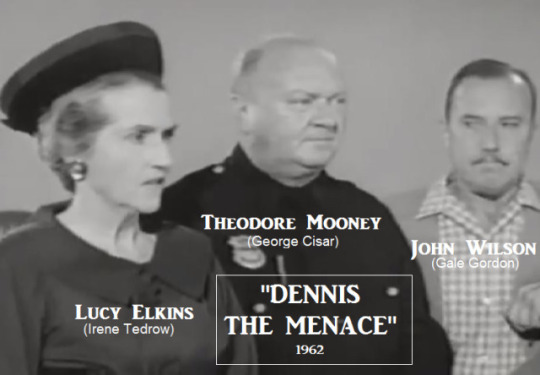
When “Dennis” was canceled and Gordon was finally free, Ball wasted no time in hiring him and had Lane’s character was written out in order to make way for a new banker, Theodore Mooney. “Dennis the Menace” also had a character named Theodore Mooney - a police sergeant (George Cisar). He was often seen in the company of a woman named Lucy (Mrs. Lucy Elkins played by Irene Tedrow, and John Wilson (Gale Gordon).
Another cast member that "Lucy" and "Dennis" had in common was Danny, a cairn terrier who played Fred the dog on "I Love Lucy" and Freemont, Mr. Wilson's dog, on "Dennis the Menace." Danny was trained by Bill Blair and owned by Frank Inn, Hollywood's busiest animal actor supplier.
Besides Gordon, Lane, and Kearns, “Dennis” also featured “Lucy Show” and/or “I Love Lucy” alumni: Mary Wickes (Miss Cathcart), Edward Everett Horton (Uncle Ned), Kathryn Card (Mrs. Biddy), Parley Baer (Captain Blast), Elvia Allman (Edna), Tyler McVey (Mr. Carlson), Dub Taylor (Opie Swanson), Norman Leavitt (various roles), Bob Jellison (Announcer), Richard Reeves (Mr. Kelly), Lurene Tuttle (Mrs. Courtland), Nestor Paiva (Gamali), Jonathan Hole (Addison Brook), Stanley Adams (Jerry Richman), Willard Waterman (Otis Quigley), Harry Cheshire (Mr. Petry), Eve McVeagh (Mrs. Purcell), Harvey Korman (Bowers), Stafford Repp (Lt. Wheeler), Verna Felton (Aunt Emma), Madge Blake (Mrs. Porter), Ellen Corby (Miss Douglas), Eleanor Audley (Mrs. Pompton), and frequent extras Leoda Richards, Leon Alton, Olan Soule, Larry J. Blake, George DeNormand, and Monty O’Grady.
THE GUMPS
The Gumps is a comic strip about a middle-class family headed by hen-pecked husband Andy. It was created by Sidney Smith in 1917, launching a 42-year run in newspapers from February 12, 1917, until October 17, 1959, just six month before the last time America saw the Ricardos and Mertzes for the last time.
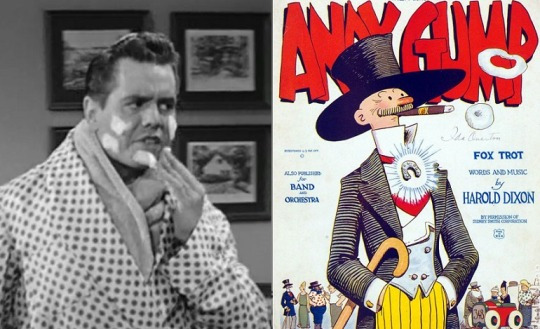
"The Adagio" (December 31, 1951) Ricky says “All this shaving is liable to wear my chin away,” to which Lucy replies “Okay, Andy Gump.”
The character had a bushy mustache but no lower jaw. Cartoonist Smith based him on real-life Andy Wheat who had his jaw removed after a tooth infection.
BUSTER BROWN
Buster Brown is a comic-strip character created in 1902 by Richard F. Outcault. Adopted as the mascot of the Brown Shoe Company in 1904, Buster Brown, along with Mary Jane, and with his dog Tige, became well known to the American public in the early-20th century. The character's name was used to describe a popular style of suit for young boys, the Buster Brown suit.

"THE ENGLISH TUTOR" (December 29, 1952) Lucy hires a grammar instructor so her new baby will grow up surrounded by well-spoken friends and family. Fred sarcastically shows up to the first session wearing a Buster Brown suit.
ETHEL: "All right, Buster Brown, go downstairs and get out of that silly outfit."

"THE RICARDOS CHANGE APARTMENTS" (May 18, 1953) To give Ricky the feeling their apartment is too small, Lucy fills the flat with toys, including a frog with a tongue that popped out when squeezed. This was actually a TV tie-in (one of the first) called Froggy the Gremlin. The character made its debut on radio’s “Buster Brown Gang” in 1944, which was brought to television in 1951 as “Smilin’ Ed’s Gang” with Froggy as a puppet and – occasionally – a life-sized costume character. In various formats, the program was seen from 1951 to 1960 (also on CBS) and featured "Lucy" performers June Foray, Vitto Scotti, Lou Krugman, Alan Reed, and Jerry Maren as Buster Brown.
BRENDA STARR, REPORTER
Brenda Starr is a comic strip started by Don Messick in 1940 about an adventurous and glamourous female reporter. The strip ended in 2011.
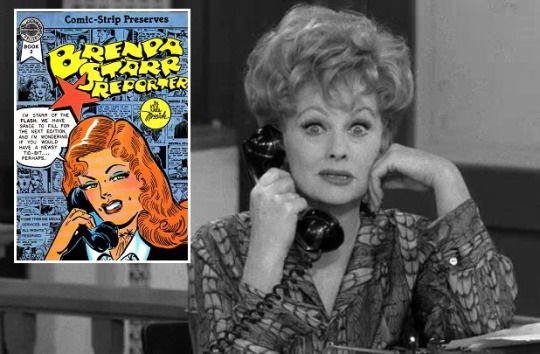
"LUCY BECOMES A REPORTER" (January 21, 1963) When Lucy takes a job as the editor of the Danfield Tribune's social column, Mr. Foley, the Tribune’s editor, sarcastically refers to Lucy as Brenda Starr.
Like Lucy, Brenda had red hair.
THE KATZENJAMMER KIDS
The Katzenjammer Kids was a comic strip created by German immigrant Rudolph Dirks which appeared from 1897 to 2006. Dirks was said to be the first to use 'thought balloons' in a comic strip.
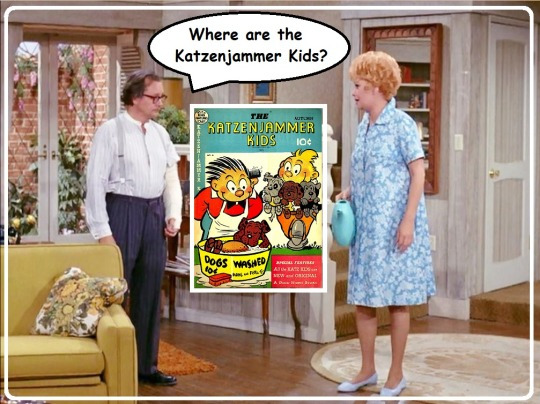
"LUCY AND THE DIAMOND CUTTER" (November 16, 1970) Wally Cox plays Gustav, a nervous diamond cutter who stays at the Carter home while waiting to cut an expensive gem. Gustav calls Kim and Craig “the Katzenjammer Kids.”
The line is humorous due to Cox's thick German accent.
BRINGING UP FATHER
"VIV VISITS LUCY" (1967) A hippie named Itchy (Les Brown Jr.) tells Viv he doesn't miss his parents because “that 'Maggie and Jiggs' action was pretty hard to take.” Maggie and Jiggs (or Jiggs and Maggie) was the colloquial name for a comic strip actually titled “Bringing Up Father.” It was created by George McManus and ran from 1913 to 2000. The strip presented the life of a nouveau-riche American family. It was translated to stage, radio, television and six films.

It is often forgotten that "I Love Lucy" was also a comic strip which appeared daily from 1952 until 1955. In fact, it was the comic strip that broke the news that Lucy Ricardo had given birth to a boy! These were then collected into "I Love Lucy" comic books. "The Lucy Show" was also a series of comic books, published by Gold Key from 1963.
#Little Orphan Annie#Lucille Ball#My Favorite Husband#I Love Lucy#The Lucy Show#Li'l Abner#Dick Tracy#batman#Brenda Starr#The Katzenjammer Kids#Dennis the Menace#Buster Brown#The Gumps#Here's Lucy#TV#Comic Strips#Comic Books#Batman#Superman#Superboy#Andy Gump#Bringing Up Father
6 notes
·
View notes
Text
Dick Tracy's Pruneface comes to Mezco's One:12 Collective
Dick Tracy's Pruneface comes to Mezco's One:12 Collective #one12collective #dicktracy
Revealed earlier this year, Dick Tracy‘s One:12 Collective Pruneface figure is now available to order! A new secret formula has been developed for the deadly Xylon bomb, capable of devastating 10 city blocks, and Pruneface and his cronies are in the middle of it all! Will Dick Tracy be able to defuse the situation before it all blows up in his face? The One:12 Collective Pruneface wears an…

View On WordPress
2 notes
·
View notes
Text
Dick Tracy #3 Review
Dick Tracy #3 Mad Cave Studios Written by Alex Segura and Michael Moreci Art by Geraldo Borges Colors by Mark Englert Letters by Jim Campbell The Rundown: Tracy continues his investigation as more corruption threatens his findings. Tracy, Pat and Tess are staking out a housing development that they are convinced is a front for the mob. After discovering that Pruneface oversees the…
0 notes
Text

"I am a feminist, but I think that story is the most beautiful love story I’ve ever heard in my life. I look at it from Rachael’s point of view. The story is about womanhood and defining womanhood through giving birth, and expressing love through that sense of family. In one sense, and this is the type of reading that can get you in trouble with people who are more strict with texts, to me it’s a love story about three people, plus the baby, and how they make that work. All the relationships in the Bible prior to that are working relationships, but there’s people and love in this story." -- Paste Magazine interview, 2009-10-15
"So the story in this song is from the Bible, and, um, one person wants to have another child, uh, with her husband, but she has grown too old. So she sends him -- this is the one part of the story that, like, I consider it an extraordinarily sweet story except for the slavery. The part you sort of have to elide. You have to do that a lot in the Bible. This is a cool story except for the part where something horrible happens and they should know better. So, so, these people want to have another baby, she can't, so she sends her slave in to her husband, but there's no indication in the story -- I mean, you can't, it's complicated politically because if you are enslaved you can't consent to anything, so, uh, but the way the story is told if you accept it on its face value, everyone is okay with this arrangement. I know, right? But let's let the story do this thing and later we can interrogate the text..." -- 2013-10-13 - People's Place - Amsterdam, Netherlands
A man, a woman, another woman, and then the child who belongs to all three of them, come screaming and beautiful into a some cool dawn several thousand years ago. When I was a kid I remember noticing that the colors on the Sunday comics pager were actually made up of thousands of individual color-dots: I would hold the paper up close to my eyes to make sure I wasn't seeing things. I wasn't. The last frame I ever saw whole before learning the truth was a picture of Pruneface, one of Chester Gould's finest. It seared itself into my memory, and then all total pictures were gone, collapsed into limitless oceans of infinite constituent parts. Still, one tries to hold onto the picture before it breaks apart. You only get to see it once." -- 7/29/2009 - The Life of the World to Come: a film by Rian Johnson, liner notes"
Oh VERY normal about John Darnielle's comments on Genesis 30:3
8 notes
·
View notes
Photo

"Now I'm Prune Tracy! Take that Dic-" I am not immune to illustrating obscure Simpsons jokes.
6 notes
·
View notes
Photo

Today’s villain is Pruneface from Dick Tracy
requested by @thepowerposter
5 notes
·
View notes
Photo

Welcome to La Conecta, Orrimaarko. #PruneFace #StarWars #K2SO #Chopper #starwarstimeshow https://www.instagram.com/p/CAyOjWnAplh/?igshid=mlb86tdv1utc
1 note
·
View note
Text
Dick Tracy (1990) makeup by Drexler and Caglione




23 notes
·
View notes